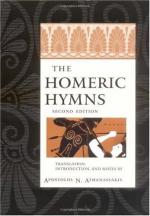HYMN TO DEMETER
THE ALLEGED EGYPTIAN ORIGINS
In what has been said as to the Greek Mysteries, I have regarded them as of native origin. I have exhibited rites of analogous kinds in the germ, as it were, among savage and barbaric communities. In Peru, under the Incas, we actually find Mama and Cora (Demeter and Kore) as Goddesses of the maize (Acosta), and for rites of sympathetic magic connected with the production of fertile harvests (as in the Thesmophoria at Athens) it is enough to refer to the vast collection in Mr. Frazer’s “Golden Bough.” I have also indicated the closest of all known parallels to the Eleusinian in a medicine-dance and legend of the Pawnees. For other savage Mysteries in which a moral element occurs, I have quoted Australian and African examples. Thence I have inferred that the early Greeks might, and probably did, evolve their multiform mystic rites out of germs of such things inherited from their own prehistoric ancestors. No process, on the other hand, of borrowing from Greece can conceivably account for the Pawnee and Peruvian rites, so closely analogous to those of Hellas. Therefore I see no reason why, if Egypt, for instance, presents parallels to the Eleusinia, we should suppose that the prehistoric Greeks borrowed the Eleusinia from Egypt. These things can grow up, autochthonous and underived, out of the soil of human nature anywhere, granting certain social conditions. Monsieur Foucart, however, has lately argued in favour of an Egyptian origin of the Eleusinia. {82}




